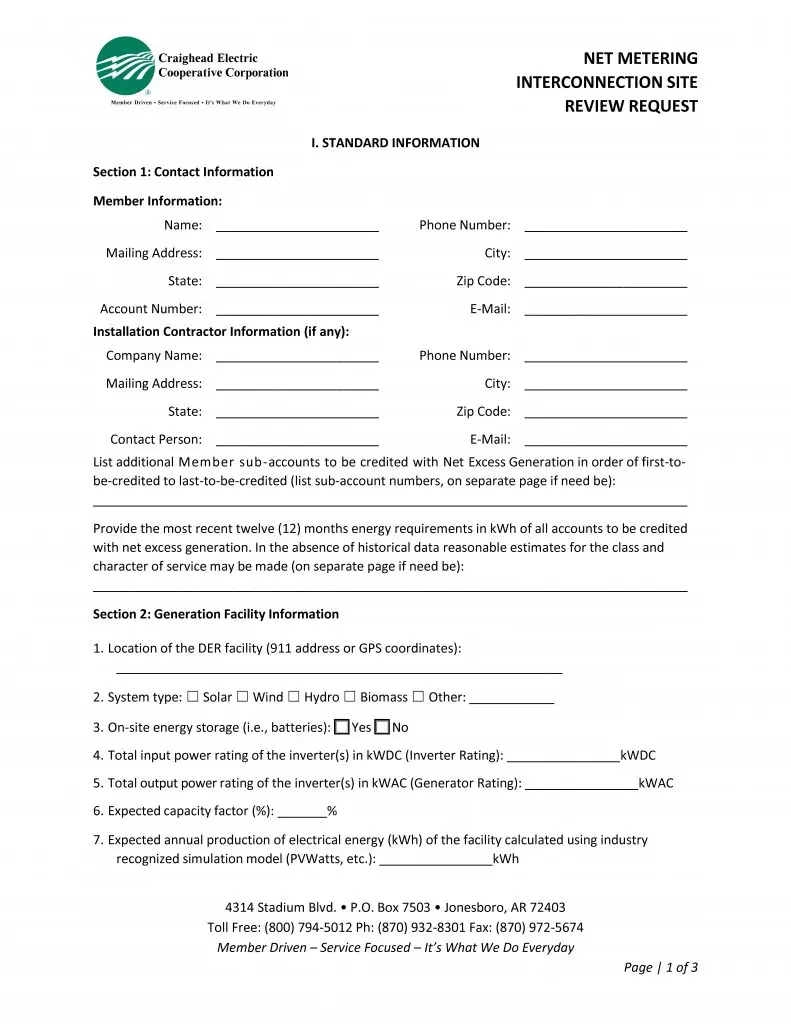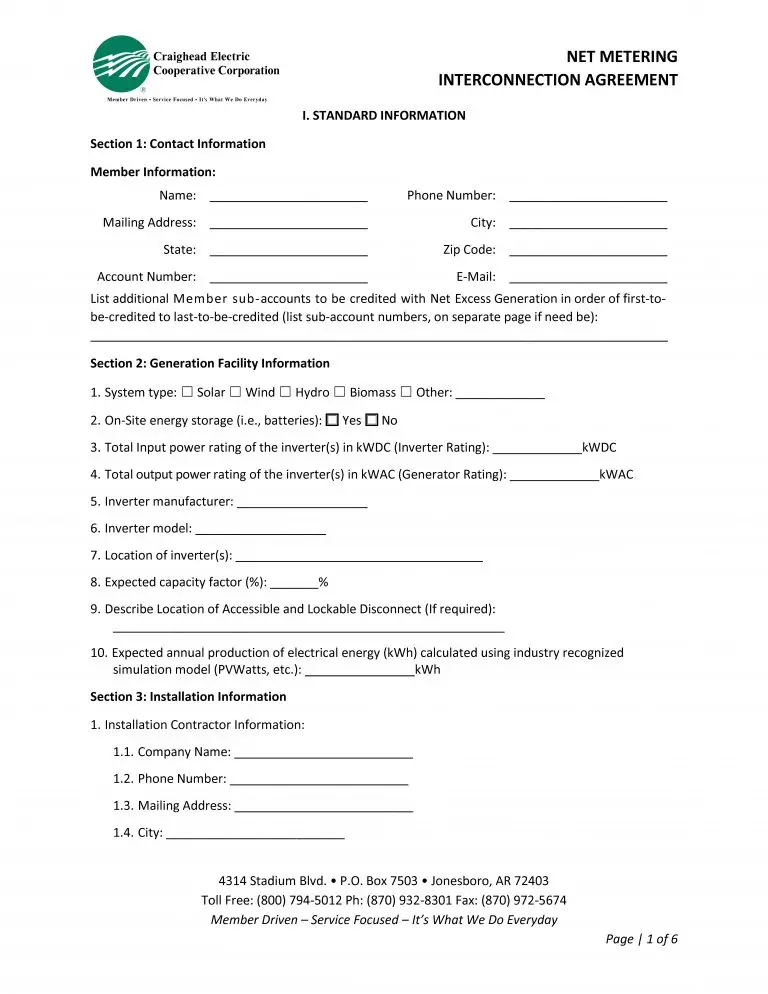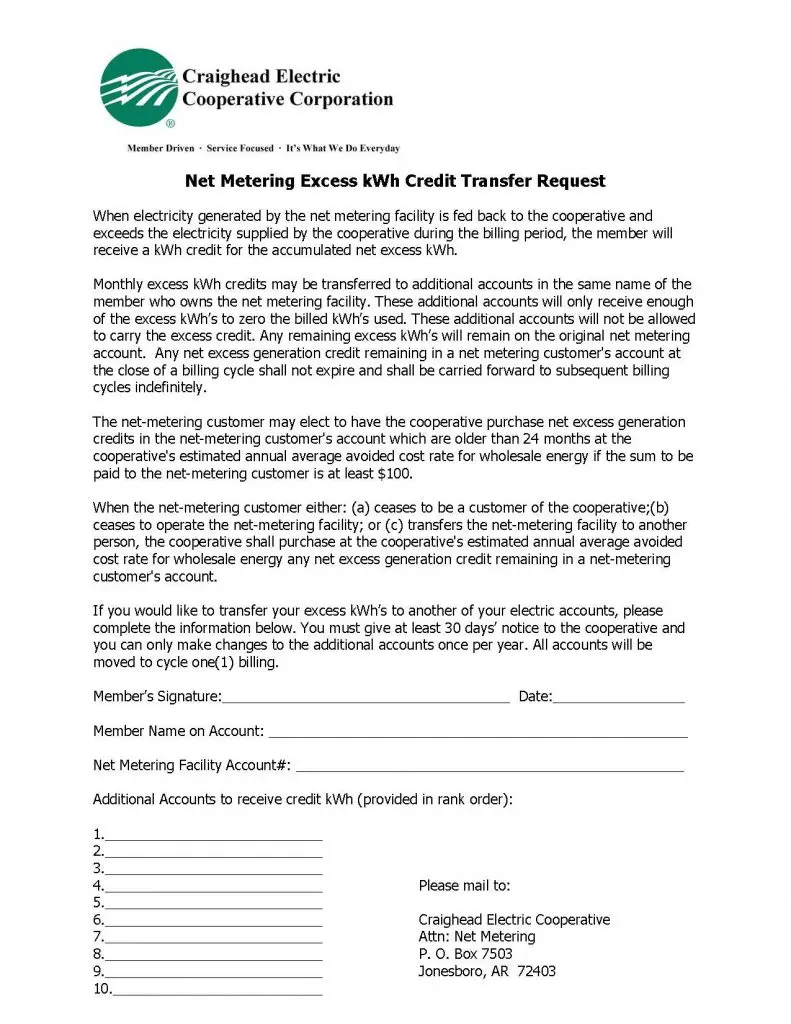Interconnection Guidelines
Member or contractor must first verify before sending in any documents
that the possible DER installation does NOT reside within a saturated area.
A Preliminary Interconnection Site Review Request must be submitted to
CECC before any construction can begin along with the required $100.00
site review feed for Level 1(25kw or less).
For systems over 25kW (level 2 through 4) site review will be $100.00 plus
$10.00 per kw of nameplate rating up to a maximum of $2000.00 plus
interconnection study cost, if needed.
The generating capacity of Net-Metering Facilities may not exceed one
thousand kilowatts (1,000kW) for non-residential use unless otherwise
allowed by the Commission.
The net metering facility must be interconnected to a metered service
billed under rate schedule 1,2,4,5,6,8,9,10 or 20 of Craighead Electric’s
metered rates.
The Craighead Electric account must be in the name of the owner of the net
metering facility.
The net metering facility must be intended primarily to offset some or all of
the net metering customer’s requirements of electricity.
The net metering system is required to meet all local and national electrical
codes, including the National Electrical Code, the Institute of Electrical and
Electronics Engineers, the National Electrical Safety Code and Underwriters
Laboratory.
The member must complete and submit a copy of the standard
interconnection agreement and ownership affirmation at least 30 days
prior to the planned interconnection.
The interconnection agreement will be signed at the time the system is
commissioned by Craighead Electric. Once equipment is installed, the
member must contact CECC to schedule a site visit for CECC personnel to
commission the installation. The net metering equipment must remain
disconnected from the electric meter until the system is inspected and
commissioned by CECC.
The interconnection must be made behind the initial means of
disconnection. That is NO LINE SIDE TAPS before the main breaker. A single
switch must simultaneously disconnect the load and the DER.
No insulation piercing taps. Interconnection must be breaker (preferred) or
terminal (Polaris) type.
All solar installations must have a lockable manual throw handle load
disconnect (air gap disconnect) breaker will NOT suffice for this disconnect.
All plan sets must include the list below:
1. Site Plan Layout
2. General Notes regarding the site plan
3. Site Information
4. Attachment Specs
5. Single Line Diagram
6. Three-line Diagram (if necessary)
7. Signage Information and location of placement (warning placards)
8. Solar Module Spec Sheet
9. Power Optimizer Spec Sheet
10.Backup Interface Spec Sheet
11.Battery Spec Sheet
12.Inverter(s) Spec Sheet
13.Combiner Spec Sheet (if applicable for micro inverters)
14.Rail System Spec Sheet
15.Disconnect Spec Sheet
Some of these Documents may not be required dependent upon the
scope of the DER installation.
Panel arrangement must reflect the plan set should the panel arrangement
need to be adjusted for construction purposes. The contractor must send in
an updated and accurate plan set depicting the panel arrangement.
The installation should reflect the correct number of panels depicted in the
plan set (if plan set depicts 24 panels the installation should have 24 panels
no shorting or adding panels). Should any changes need to be made to the
quantity of panels the contractor must notify CECC as well as send in and
up to date an accurate plan set.
All plan set information should be accurate and true to what is installed in
the field. Should the installation deviate from the original plan set the
contractor must notify CECC and will require an up to date and accurate
plan set.
Should a generator transfer switch be installed or is already present on a
residence it must be reflected within the plan set and SLD.
The kWAC output of the inverters as well as the manufacturer and model
should be accurate and correctly correspond with the information on the
Site Review Request Form and the ICA.
The kWDC output of the panels should be accurate and correctly
correspond with the information on the Site Review Request Form and the
ICA.
Should an interconnection occur inside an interior service panel. The
contractor should take pictures of the interconnection and submit the
photos at the time construction has been completed. This is to verify that
the interconnection was not installed above the primary means of
disconnect and that no insulation piercing tap connectors were used.
Electrician information and license number must be accurate to what is
displayed within the Arkansas Department of Labor website when
submitted into the Microsoft forms link.
Should the owner of the DER have any issues or cause any issues on either
an individual or shared transformer the owner of the DER will be
responsible for any upgrade that is needed to mitigate the issue.
The owner of the DER will be subject to an annual Net Metering inspection
to verify that all DER equipment is functioning and operating correctly.
All non-export(zero-export) systems will go through the same process of
interconnection as a regular Net Metered account.
Non-Export(zero-export) systems must meet the following two criteria:
1. To ensure at least a minimum amount of power is imported across
the Point of Common Coupling at all times (and therefore, that
power is not exported), an under-power Protective function must be
provided. The default setting for this Protective Function shall be 5%
(import) of the generating unit’s total Nameplate Rating, with a
maximum 2.0 second delay.
2. Generating Facilities must utilize, a Nationally Recognized Tested
Laboratory (“NRTL”) Certified Power Control System and inverter
system that results in the Generating Facility disconnecting from the
Electric Delivery System, ceasing to energize the Electric Delivery
System or halting energy production within 2 seconds if the period of
continuous inadvertent export exceeds 30 seconds. Failure of the
control or inverter system for more than 30 seconds, resulting from
loss of control or measurement signal or loss of control power, must
result in the Generating Facility entering an operational mode where
no energy is exported across the Point of Common Coupling to the
Electric Delivery System.
A Non-Export account is not eligible to receive excess credits if the member
has another Net Metered account.
A Non-Export Member must sign the Addendum to the Net Metering
Interconnection Agreement
A Non-Export system will have a Net Meter installed for the cooperative to
monitor and ensure that the N.E. system is functioning properly.
A Non-Export Net Meter must maintain an absolute zero on the “received”
Meter register. Should the Non-Export system have any amount of
exportation the DER will be subject to disconnect.
- Member or contractor must first verify before sending in any documents that the possible DER installation does NOT reside within a saturated area.
- A Preliminary Interconnection Site Review Request must be submitted to CECC before any construction can begin along with the required $100.00 site review feed for Level 1(25kw or less).
- For systems over 25kW (level 2 through 4) site review will be $100.00 plus $10.00 per kw of nameplate rating up to a maximum of $2000.00 plus interconnection study cost, if needed.
- The generating capacity of Net-Metering Facilities may not exceed one thousand kilowatts (1,000kW) for non-residential use unless otherwise allowed by the Commission.
- The net metering facility must be interconnected to a metered service billed under rate schedule 1,2,4,5,6,8,9,10 or 20 of Craighead Electric’s metered rates.
- The Craighead Electric account must be in the name of the owner of the net
metering facility. - The net metering facility must be intended primarily to offset some or all of the net metering customer’s requirements of electricity.
- The net metering system is required to meet all local and national electrical
codes, including the National Electrical Code, the Institute of Electrical and
Electronics Engineers, the National Electrical Safety Code and Underwriters
Laboratory. - The member must complete and submit a copy of the standard interconnection agreement and ownership affirmation at least 30 days prior to the planned interconnection.
- The interconnection agreement will be signed at the time the system is commissioned by Craighead Electric. Once equipment is installed, the member must contact CECC to schedule a site visit for CECC personnel to commission the installation. The net metering equipment must remain disconnected from the electric meter until the system is inspected and commissioned by CECC.
- The interconnection must be made behind the initial means of disconnection. That is NO LINE SIDE TAPS before the main breaker. A single switch must simultaneously disconnect the load and the DER.
- No insulation piercing taps. Interconnection must be breaker (preferred) or terminal (Polaris) type.
- All solar installations must have a lockable manual throw handle load disconnect (air gap disconnect) breaker will NOT suffice for this disconnect.
- All plan sets must include the list below:
1. Site Plan Layout
2. General Notes regarding the site plan
3. Site Information
4. Attachment Specs
5. Single Line Diagram
6. Three-line Diagram (if necessary)
7. Signage Information and location of placement (warning placards)
8. Solar Module Spec Sheet
9. Power Optimizer Spec Sheet
10.Backup Interface Spec Sheet
11.Battery Spec Sheet
12.Inverter(s) Spec Sheet
13.Combiner Spec Sheet (if applicable for micro inverters)
14.Rail System Spec Sheet
15.Disconnect Spec Sheet
Some of these Documents may not be required dependent upon the scope of the DER installation.
- Panel arrangement must reflect the plan set should the panel arrangement need to be adjusted for construction purposes. The contractor must send in an updated and accurate plan set depicting the panel arrangement.
- The installation should reflect the correct number of panels depicted in the plan set (if plan set depicts 24 panels the installation should have 24 panels no shorting or adding panels). Should any changes need to be made to the quantity of panels the contractor must notify CECC as well as send in and up to date an accurate plan set.
- All plan set information should be accurate and true to what is installed in the field. Should the installation deviate from the original plan set the contractor must notify CECC and will require an up to date and accurate plan set.
- Should a generator transfer switch be installed or is already present on a residence it must be reflected within the plan set and SLD.
- The kWAC output of the inverters as well as the manufacturer and model should be accurate and correctly correspond with the information on the Site Review Request Form and the ICA.
- The kWDC output of the panels should be accurate and correctly correspond with the information on the Site Review Request Form and the ICA.
- Should an interconnection occur inside an interior service panel. The contractor should take pictures of the interconnection and submit the photos at the time construction has been completed. This is to verify that the interconnection was not installed above the primary means of disconnect and that no insulation piercing tap connectors were used.
- Electrician information and license number must be accurate to what is displayed within the Arkansas Department of Labor website when submitted into the Microsoft forms link.
- Should the owner of the DER have any issues or cause any issues on either an individual or shared transformer the owner of the DER will be responsible for any upgrade that is needed to mitigate the issue.
- The owner of the DER will be subject to an annual Net Metering inspection to verify that all DER equipment is functioning and operating correctly.
- All non-export(zero-export) systems will go through the same process of interconnection as a regular Net Metered account.

Preliminary Interconnection Site Review Request Form
Click on image to download

Standard Interconnection Agreement Form
Click on image to download

Net Metering Excess Kwh Credit Transfer Request(PDF)
Click on image to download
